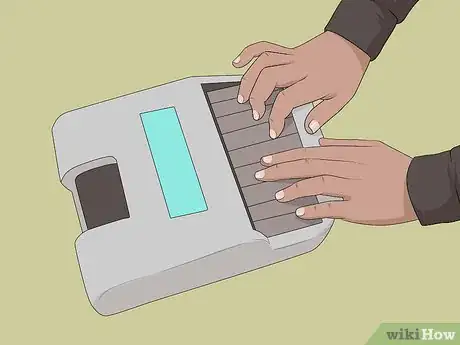This article was co-authored by wikiHow Staff. Our trained team of editors and researchers validate articles for accuracy and comprehensiveness. wikiHow's Content Management Team carefully monitors the work from our editorial staff to ensure that each article is backed by trusted research and meets our high quality standards.
This article has been viewed 47,621 times.
Learn more...
If you meet someone for the first time and think they may be deaf, you may be tempted to ask directly. However, you may wonder how to respectfully communicate with someone who you aren’t sure can hear. It’s best to start a conversation with someone you think may be deaf by asking what their preferred method of communication is. Often, a deaf person will be able to read your lips well enough for the two of you to enjoy a conversation comfortably, although visual aids and writing can provide quick clarification whenever necessary.
Steps
Introducing Yourself to Someone Who May Be Deaf
-
1Get their attention before speaking. If someone cannot hear you, make yourself visible to them before trying to communicate further. Position yourself in their field of vision and speak with both your body and face facing in their direction. A small wave or another friendly hand motion may also help get someone’s attention.[1]
- Do not hesitate to initiate a conversation simply because you think someone may not be able to hear you.
- While it may require a bit of mutual effort to establish a way of communicating if someone does happen to be deaf, you will likely be able to do so together with ease.
-
2Introduce yourself. If you’re meeting someone for the first time, identify yourself. If you are meeting someone in a professional or otherwise formal scenario, you may also want to provide a business card. If you’re wearing a name badge, feel free to present it.
- Try to introduce yourself somewhere quiet. Background noise can make it very challenging for someone with partial hearing to understand you.
- In the course of introducing yourself to someone who is deaf, they will likely indicate that they cannot hear, and may indicate a different type of communication. If they do, immediately switch to this form of communication.
Advertisement -
3Ask how they prefer to communicate. You’ll likely be able to tell whether another person can hear you or not, whether or not they explicitly state that they are deaf. If, for instance, they seem to understand what you’re saying – they probably can, whether or not they can hear. Someone who cannot hear may still be fully capable of understanding most of what you’re saying through lip-reading and/or partial hearing.
- If speaking is working, and a conversation is going smoothly, continue doing so until they, and focus on speaking slowly and clearly.
- If you’re struggling to communicate by voice, say something along the lines of, “How do you prefer to communicate?”
-
4Hold off on asking whether someone is deaf. As you establish how best to communicate with someone, their ability to hear will likely naturally come up in conversation, or become apparent without talking about it. Further, the word “d/Deaf” is commonly used in two different ways, so avoid complicating your interaction by starting a conversation asking about someone's potential deafness. The important thing to remember is that you should not assign labels to someone or assume they see themselves a certain way.
- If you simply ask someone whether they are deaf, they may not know whether you’re asking about their ability to hear (deaf), or about whether they identify with a certain culture (Deaf).
- Never use phrases such as “hearing impaired,” which has negative connotations.
- Keep in mind that many people who are deaf do not view themselves as disabled, nor believe there is anything wrong with them.
Making Sure Someone Can Read Your Lips
-
1Do not stand in front of anything bright. If the person you’re speaking with may be reading your lips, do not sit or stand in between them and whatever is providing light. This applies to sunlight as well as artificial light sources. Glare or shadows on your face will make lip reading much harder, if not impossible.[2]
-
2Look at the other person when speaking. Maintain a position relative to the other person that allows for a full, well-lit view of your face. If you need to turn away, to write on a whiteboard, for instance, wait to do so until you’re finished speaking.
-
3Avoid yelling or exaggerating your enunciation. While you may be doing so in the interest of being understood, many people who are hard of hearing may take offense to shouting or dramatic pronunciation. Further, exaggerating your voice or overemphasizing certain sounds may actually make reading your lips harder. Enunciate your words normally, without adding emphasis or emotion.
-
4Speak in short sentences. Short sentences are easier to communicate with, in the statements you are making will be more precise and concise. Since nouns and verbs will likely convey the substance of what you’re trying to say, focus on using these types of words, as opposed to adjectives and adverbs.
-
5Keep your mouth fully visible. Do not obscure your lips in any way. This means not smoking, eating, or chewing anything while communicating with someone who is reading your lips. Additionally, take care not to touch your face while speaking, as you may obscure sight of your lips.
Developing a Conversation Together
-
1Indicate what you want to talk about. Even if you simply want to introduce yourself, it can be helpful to indicate the reason you want to communicate with someone who may not be able to hear you. For instance, if there is certain topic you’re hoping to discuss, and you have anything relevant to that topic, hold it up or simply touch it.
-
2Repeat once, then rephrase. If it seems that something you’ve said was not understood, say it again. If this does not convey your point again, rephrase what you’re trying to say using different words. Often, the particular way you may be mouthing certain words may look like another word. Re-phrasing the same statement with different words will likely quickly clarify anything you’ve said that may have been unclear.
-
3Maintain eye contact. This is the best way to convey a feeling of direct communication, even if you’re having a hard time understand each other. In fact, you may even feel as though a deaf person is staring at you. They probably are, and you should try to maintain almost complete eye contact as well.[3]
- Imagine if someone who had full hearing covered their ears while you were speaking to them. To someone who relies on lip reading, avoiding eye contact sends a similar message.
-
4Be polite. While it goes without saying that you should be polite when conversing with other people, there are specific things to be conscious of when communicating with a deaf person. If you hear something you need to respond to, explain what you are doing. For instance, if the telephone rings or someone knocks at the door, say what you’re doing before you get up to answer it.
- Never act as though a deaf person is not present. Do not speak exclusively to another person while someone who cannot hear is present. Speak towards the deaf person so they can read your lips and expressions, even if what you’re saying is more pertinent to a third party.
-
5Employ visual clarifications. Whenever photos, drawings, or other visuals may aid or strengthen your ability to communicate with one another, refer to them. Similarly, pantomime an action or behavior, or use body language and facial expression to emphasize certain points. The way your moving alone can strongly emphasize what you’re saying.[4]
-
6Focus on listening. A deaf person may or not speak. If they do speak, their verbal communication may be hard for you to understand. If you do not understand something, however, never act as though you do. Instead, ask the person you’re conversing with to repeat themselves.[5]
- Remind yourself that strong communication requires the patience to fully understand what another person has to say.
- Ask specific questions. If a question can potentially be answered in a few words, ask it in a way that will allow for a short response, or even merely a nod or shake of the head.
Using Writing to Communicate
-
1Write down what you’re hoping to convey. In this scenario, the medium is not the message. If you’re struggling to be convey yourself effectively, or if the person with whom you are communicating is unable to hear you or read your lips, break out some writing equipment.
- First, ask if the other person is comfortable with written communication. Do not assume that a deaf person will prefer to write.
- You can use a writing utensil and paper, or use a smartphone or computer to exchange written statements.
-
2Keep written messages short and simple. After establishing that the other person is comfortable writing out a conversation, state the subject area or ask them to do so. This will help get your both on the same page at the beginning of a conversation. You likely only need to write a few words at a time. Allow the deaf person to see what you’re writing as you write, as they will likely understand what you’re trying to convey before you’ve written it all out.
-
3Face them after giving them a written message. You should still try to maintain lots of eye contact and use body language indicating that your focus is on the conversation. For instance, sit or stand with your body facing the other person, and watch their face whenever you are not writing.
- You will read each other’s facial expressions as much as the content you’ve written. This will make communication more comprehensible, not to mention more accurate.
-
4Get assistance for nuanced conversations. If your conversation progresses, the person you are speaking with may want to use software such as Computer-Aided Real-Time Transcription, which will allow them to read what you are saying as you speak.
References
- ↑ https://blog.cudoo.com/deaf-etiquette-dos-and-donts-you-need-to-know
- ↑ https://blog.cudoo.com/deaf-etiquette-dos-and-donts-you-need-to-know
- ↑ https://www.startasl.com/deaf-culture
- ↑ https://blog.chsc.org/blog/12-tips-for-communicating-with-a-deaf-person
- ↑ https://blog.chsc.org/blog/12-tips-for-communicating-with-a-deaf-person










































































